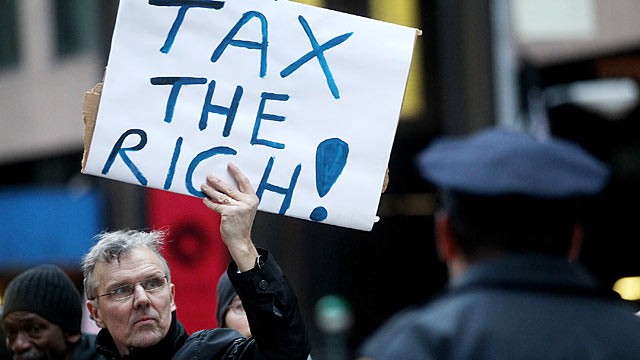Tax-the-Rich Proposal Contradicts Itself
Income Tax Hike on Wealthy would Cost Jobs and Fall Short of its Goal
Download a PDF of the Policy Analysis here …
Background: In February 2012, a bill was submitted in the Rhode Island House of Representatives that would raise income taxes on individuals making over $250,000 in order to raise $118 million for social safety net programs. The bill includes a provision that the income tax hikes on the wealthiest Rhode Islanders would be temporary, in that those taxes would be gradually reduced as the unemployment rate drops. This concept is a contradiction in itself. Additionally, the bill would be poor public policy for our state, and the bill would not achieve its stated goal.
Analysis: Given the Ocean State’s fragile economy, any rise in taxes will put downward pressure on economic activity and will tend to raise the unemployment rate. A tax plan that is contingent on a decrease in the unemployment rate, but which itself serves to increase the unemployment rate, is contradictory and counter-productive.
An analysis by RI-STAMP (an economic modeling tool utilized by our RI Center for Freedom & Prosperity) of this proposal to raise income taxes by 4% on Rhode Islanders with the highest incomes, is projected to yield the following results and unintended consequences [1]:
• $13 million less than the $118 million in state tax receipts anticipated (or $105 million net)
• Loss of 1,372 jobs, increasing the unemployment rate by about ? of 1% (see Report Card reference)
• Loss of about 1,000 residents (0.09%, see Report Card reference)
Explanation: As with the laws of physics, economic laws are not easily changed by public policy. When something is taxed, it costs more, and the result will be less of it.
This is a common and fundamental miscalculation when it comes to projecting the effects of tax policy on tax receipts. Too often, the more short-sighted and simplistic “static”, or straight-line, calculation is utilized, when in reality the more complex “dynamic” impact should be evaluated. The downstream, ripple effects of tax policy on various aspects of the economy are rarely discussed or attempted to be quantified, either at the state or municipal level. RI-STAMP seeks to fill this void.
In summary, this tax hike plan will not reach its intended goal, as lower revenues will be realized and the state’s tax base will be reduced, while at the same time increasing the number of people who will qualify for or request aid.
Rhode Island’s Competitive Status: Other proposals to tax the rich have also been floated in the state, most with the aim of raising enough new revenues to fund planned spending levels.
The stated position of the RI Center for Freedom is that balancing the budget is the wrong goal for the Ocean State.
Seeking to balance the budget tacitly approves the current budget, and signifies that current spending and tax levels are effective for our state … they are not. The Competitiveness Report Card recently published by our Center illustrates how broadly non-competitive Rhode Island has become as compared with our New England neighbors and nationally.
The Ocean State’s tax burden and overall business climate already grade out at “F” … any increase in the income tax, would make this dire situation even worse.
In fact, in the area of ‘Personal Income Tax Rates’, Rhode Island currently grades a “C”; one of only two areas in the entire Tax Burden category that is not an “F”. By raising the income tax as proposed, this area would itself become an “F”, worsening our already dismal competitive standing … and imposing yet another stigma on Rhode Island as an excessively high tax state, even by New England standards.
In the sub-categories of Population Growth and Net Domestic Migration, Rhode Island also grades “F”. Our state cannot afford to lose more population by driving or keeping people out due to a higher income tax.
This kind of incremental tax-hike thinking, repeatedly over the recent decades, is what has steadily degraded the Ocean State’s ability to compete for the human and capital resources that are required to reinvigorate and grow our economy.
The message from this tax increase would be clear to businesses and individuals who have the mobility to move to or settle in other states … Rhode Island imposes a hostile level of taxes.
Alternative Recommendation: If instead, we would prefer to hang a “welcome” sign, the State must find the courage to cut taxes … and to cut spending. This is the best way to improve our standing in New England. This alternative line of thinking can help reverse the outflow of people and money from our state, and will help us attract the new investment in our state that is necessary to see our business sector expand so as to provide good jobs for our citizens.
Conclusion: A policy of tax “reduction” is consistent with an unemployment rate decrease. This proposed policy of tax “increase” is contradictory to it.
WHAT IS RI-STAMP?
Developed by the Beacon Hill Institute at Suffolk University, RI-STAMP is a customized, comprehensive model of the RI state economy, designed to capture the principal effects of city tax changes on that economy. In general STAMP is a five-year dynamic computable general equilibrium (CGE) tax model. As such, it provides a mathematical description of the economic relationships among producers, households, government and the rest of the world. It is general in the sense that it takes all the important markets and flows into account. It is an equilibrium model because it assumes that demand equals supply in every market (goods and services, labor and capital); this is achieved by allowing prices to adjust within the model (i.e., prices are endogenous). The model is computable because it can be used to generate numeric solutions to concrete policy and tax changes, with the help of a computer. And it is a tax model because it pays particular attention to identifying the role played by different taxes [2].
End Notes
[1] The RI-STAMP model does not break out incomes at the “$250,000 and higher” level. We determined it would be a more accurate simulation to project the impact of a general $118 million income tax increase, in lieu of a 4% raise on the model’s “$125,000 and higher” level.
[2] The Beacon Hill Institute, What Is STAMP?; http://www.beaconhill.org/STAMP-Method/STAMP.pdf


Leave a Reply
Want to join the discussion?Feel free to contribute!